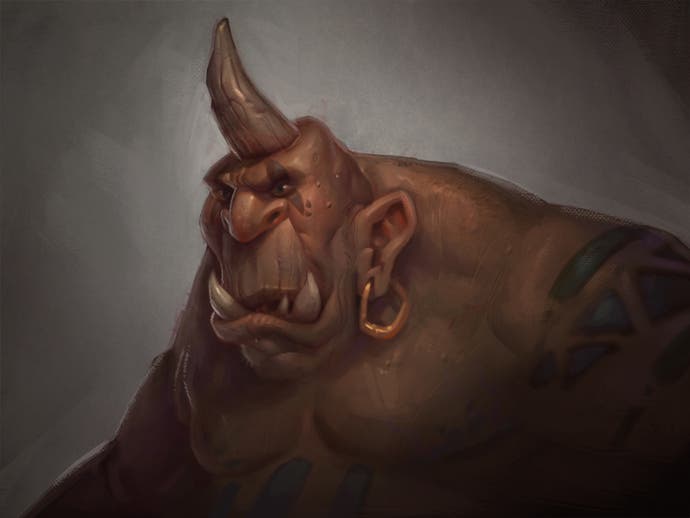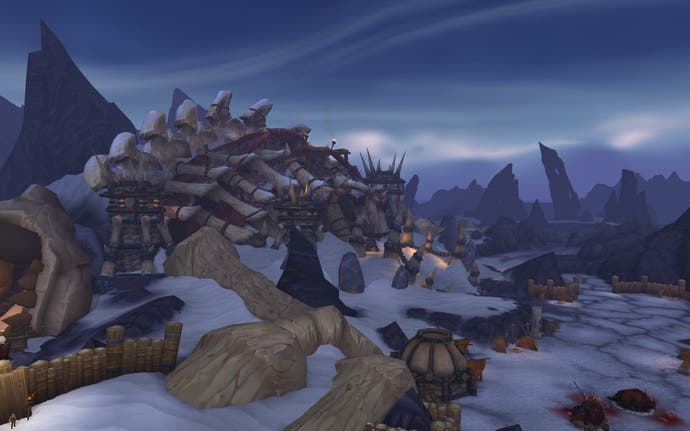Blizzard sets a steady course for WOW with Warlords of Draenor
With a classic Warcraft feel and fan-pleasing features, the MMO is entrenching in its old age.
Last year, World of Warcraft was at something of a crossroads. With subscriptions falling and new contenders like Guild Wars 2 and The Old Republic applying pressure like never before, it was hard not to see Mists of Pandaria as Blizzard's one last big attempt to revive the game's fortunes and draw a whole new audience. It didn't really work out, but that's okay. The audience World of Warcraft retains is nothing to sniff at, and it's that audience that Warlords of Draenor seems primarily aimed at. There's no new low-level content on offer, no big surprises like Pandaria's pet battles that might suddenly attract players who were never going to buy into today's questing and raiding, and the story underpinning it is a deep-dive into Warcraft lore that's going to be most appreciated by players whose Warcraft experience started way back in Orcs And Humans.
The main plot, in a nutshell, is that fallen Warchief Garrosh Hellscream has teamed up with a mysterious benefactor to escape his imprisonment at the end of Pandaria and head back in time to first prevent the Horde from coming under the thumb of the Burning Legion, and then tool it up with advanced technologies to conquer the present. Both Alliance and Horde follow him back through time to stop this new Iron Horde in its tracks, unaware that bigger wheels are spinning in the background. Blizzard has already stated that there's a man behind the orc, and that fans can probably have a good guess at who it might be.
That's already a lot of lore to handle before setting off on the suicide mission that starts the new campaign, but Lead Quest Designer Craig Amai isn't worried. "When you look at Warcraft and the experience, it tends to be about the setting. Whatever methods we use to get you back to Draenor, when you're there, it's this savage world with the orcs in their prime and it doesn't take a lot to get people really invested once they're there."

Helping this is the fact that while, much like Pandaria, the new content is aimed at high level play, Blizzard is giving everyone a one-time boost to Level 90 - either a promotion for your existing character or a free Level 90 alt. Your other characters will have to take the slow route though, as usual. Blizzard's intention with this is to get everyone playing together and focused on the new content, so that new and returning players aren't stuck playing alone for weeks while existing friends devour the new content without them. To make things easier, boosted characters will also get a little extra training before beginning the Draenor campaign.
"When you hit 90, we'll be putting you through a suicide mission experience, and if you've boosted a character we're going to be unlocking your abilities and familiarising yourself with your class over that zone. That will give you a little time to get up to speed," explained Amai. But what of the classic argument that you need the levelling curve to actually know how to play your class? Blizzard doesn't see that as being a problem. "We've got 10 levels of content, and as much as you can argue that it takes time to ramp up and get familiar with your chosen class, it doesn't take 90 levels. Especially with us helping you on the way."
The result is that everyone will be able to access and be effective in the new zones immediately - despite them being a savage, unforgiving place. Draenor is actually somewhere we've been before - The Burning Crusade's Outland, only seen in its prime. Shadowmoon Valley for instance is no longer a Fel-infested wasteland, but a beautiful, perpetually nocturnal forested valley. Its centrepiece, Karabor, is best known to WoW players as The Black Temple - the imposing lair of horned preparedness advocate Illidan. Now though, it's a Draenei holy place, and the Alliance's home city. With these changes, it's going to be a familiar place with some instantly recognisable landmarks, like Shattrath, but also a fresh one - and it's all been completely redone from scratch. Sadly, Outland is not getting a Cataclysm style spit-polish, leaving levels 60-70 somewhat dull. "We're really focused on getting everyone to play together in the endgame, in the same space, so we're not spending a lot of time going back to Outland," said Amai.
While there was only time at Blizzcon to have a quick hands-on with the new game, you shouldn't expect many mechanical surprises. I got to explore a bit of Shadowmoon Valley, which was attractive, but didn't encounter anything as immediately stunning as some of Pandaria's early areas, or any major tweaks to freshen up the action. Instead, Draenor feels like it's working through a shopping list of things players have long wanted to see fixed, from bags being easier to use to player characters finally having been updated - and looking damn good compared to the primitive models of old.

Mechanically though, expect tweaks rather than revolution, with Blizzard continuing to test ideas in one expansion and expanding them later on. Raids and dungeons have always been tough to get into, with the ease of physically jumping in via Looking For Dungeon/Raid not mirrored by much that actually teaches you the ropes in the absence of a friend or helpful guild willing to provide direct tutoring.
"We've already acted on some of this," says Amai. "The Proving Grounds in Pandaria for instance take the initial step of familiarising you with roles you might not have seen in questing in a safe solo environment. You'll also notice that on the Timeless Isle, you get things like the semi-Elite creatures that can be group but also solo. I'd expect to see more of that in Draenor. We've been putting in these optional challenges along the way to the endgame, and we want to use those to bridge the gap and get used to the complexities."
By far the biggest addition though is player-housing, demanded even before the original World of Warcraft. Blizzard's approach is slightly different to most though, providing a base that uses phasing to become part of your world (and thus visible when you run by, fly over or invite guests) and can be placed in multiple zones. Here, you'll build structures, recruit followers and send them off on missions, and store trophies of past glories, with the ability to pick everything up and move elsewhere in the world on a whim.
It's a somewhat odd addition though, with building a base seemingly more appropriate for a guild than for individual players. Amai didn't deny this, saying simply "The philosophy is that we want to take housing and make it all about the core fantasy of building up a base and customising it - getting some payoff to your decisions. To get substance in there, we had to make it about individual choices." More pressingly, neither he nor Production Designer J Allen Brack were prepared to talk about the long-term future of these bases, and whether they'd continue to be part of the game next time, or become as irrelevant as a Pandarian farm in a couple of years. Amai summed up the thinking as "The intention is that this is your base in Draenor. We're not sure what we want the long-term to be." To this, Brack nodded, adding "Fan reaction is how it all comes together. We have how we think it's going to come together, but that's the deciding factor."
For such a lore heavy expansion, another big picture question also had to be asked - what of the supposed war between the Alliance and the Horde? Mists of Pandaria brought the two to open conflict, but ended with both sides seemingly having lost the taste for it. Is it time to just admit that it's not really happening?
"It's kind of core to the game, right? The conflict between the two factions?" asked Amai. And well, yes. But also, no. It's almost always rogue factions and outside threats causing the trouble and forcing the two sides into the same goal. Even in Pandaria, the Horde quickly ended up agreeing with the Alliance that Garrosh had to be dealt with.
"Well, there's uneasy alliances, right? It's to the modern world - you rarely see one side stamped out entirely. You reach that point where the conflict has to cease temporarily. We want to create peaks and valleys in conflict. We want to have opportunities where you're stepping away to deal with a communal villain and then come back and portray the conflict somewhere else. Sometimes that's isolated to our PvP areas. Other times, such as in Lich King, we show a divisive moment like the Wrathgate that tears them apart."

And this time? "I think with Draenor, you can expect a lull. You're going on a suicide mission through the portal, not bringing the armies of the Horde and Alliance, and you need to make new friends. That's going to be the valley that will build things up and lead to that conflict starting up again."
The deep valley that's facing Azeroth's finest right now though is that with Pandaria's story concluded, it's going to be a long, long wait before Draenor's infusion of new content. No release date has been announced, which almost certainly means we're looking at just under a year. It's a long time to hold on, and while it's the same cycle that World of Warcraft has always worked on, times do change. Recent developments like ArenaNet pushing a six week update cycle and F2P games having to keep things flowing in the name of their bottom line have made any wait measured in years officially feel like forever.
I asked Brack why it takes so long for new content to be rolled out, even allowing for the fact that Blizzard's stock response to that kind of question has long been "We're Blizzard." Couldn't we just get smaller additions more regularly? Sadly, no. While adding that there have been several patches, large and small, the official word is "We think Mists of Pandaria is about the right size for an expansion - that number of zones and systems is about what we want to hit."
Even at this measured pace though, World of Warcraft is in little danger for the moment. It'll take millions more subscribers lost before it ceases to be Blizzard's entire farm of golden geese, and indeed Blizzard boss Mike Morhaime is quick to point out "In terms of the content and developing, we have more resources focused on developing content for World of Warcraft than ever before. So we expect to continue having a long and happy life."
Warlords of Draenor should stand to benefit from that army of developers more than most previous expansions, if only because all of that attention is being poured into one area, with no distractions like starting areas and additional class balance to dilute the action. It may not draw in too many new players, or keep others around past the level cap, but Amai hopes it will at least tempt a few to make a return to the fold. "When you combine (our new experiences) with jumping to 90 so that your friends can just play with you, you can act on all that nostalgia. It's a good time to pull everyone back in."

